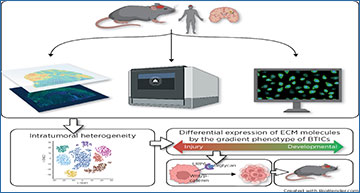Glioblastomas (GBM) are aggressive brain tumors with extensive intratumoral heterogeneity that contributes to treatment resistance. Spatial characterization of GBMs could provide insights into the role of the brain tumor microenvironment in regulating intratumoral heterogeneity. University of Calgary researchers performed spatial transcriptomic and single-cell analyses of the mouse and human GBM microenvironment to dissect the impact of distinct anatomical regions of brains on GBM. In a syngeneic GBM mouse model, spatial transcriptomics revealed that numerous extracellular matrix (ECM) molecules, including biglycan, were elevated in areas infiltrated with brain tumor-initiating cells (BTIC). Single-cell RNA sequencing and single-cell assay for transposase-accessible chromatin using sequencing showed that ECM molecules were differentially expressed by GBM cells based on their differentiation and cellular programming phenotypes. Exogeneous biglycan or overexpression of biglycan resulted in a higher proliferation rate of BTICs, which was associated mechanistically with low-density lipoprotein receptor-related protein 6 (LRP6) binding and activation of the Wnt/β-catenin pathway. Biglycan-overexpressing BTICs developed into larger tumors and displayed mesenchymal phenotypes when implanted intracranially in mice. This study points to the spatial heterogeneity of ECM molecules in GBM and suggests that the biglycan-LRP6 axis could be a therapeutic target to curb tumor growth.
Mirzaei R, D’Mello C, Liu M, Nikolic A, Kumar M, Visser F, Bose P, Gallo M, Yong VW. (2023) Single-Cell Spatial Analysis Identifies Regulators of Brain Tumor-Initiating Cells. Cancer Res 83(10):1725-1741. [abstract]





